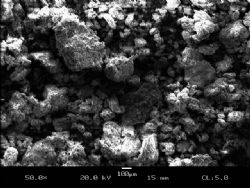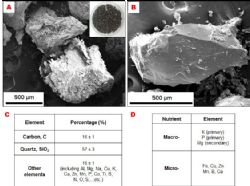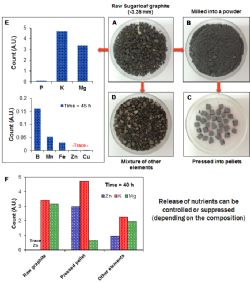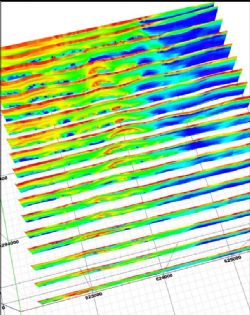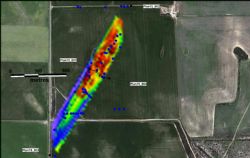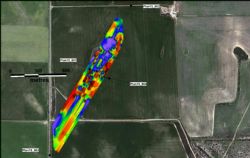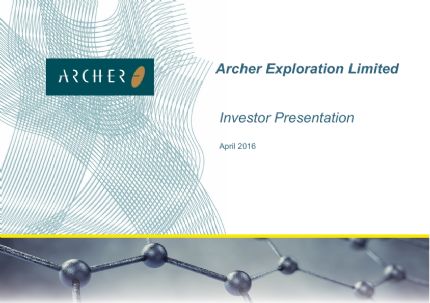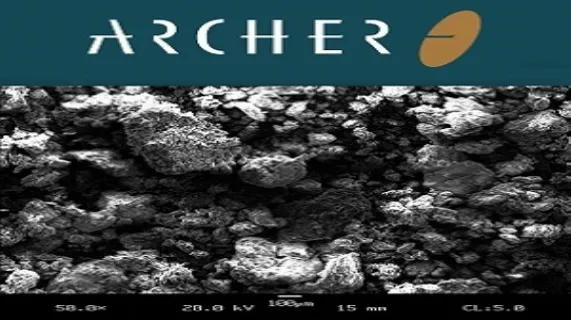
Outstanding Opportunity for Sugarloaf Graphite
Adelaide, June 29, 2015 AEST (ABN Newswire) - Archer Exploration Limited ( ASX:AXE) is pleased to announce significant progress in research to identify potential large scale uses for Sugarloaf "carbon" which has unique physical and chemical characteristics that open the opportunity for run-of-mine graphite to be mined and sold as a finished soil conditioner.
ASX:AXE) is pleased to announce significant progress in research to identify potential large scale uses for Sugarloaf "carbon" which has unique physical and chemical characteristics that open the opportunity for run-of-mine graphite to be mined and sold as a finished soil conditioner.
Highlights:
- Archer lodged the Draft Campoona Mining Lease Proposal to the government on 14th May 2015 and Campoona will be the Company's first graphite mining operation.
- Sugarloaf graphite is planned to compliment ultra-pure Campoona Shaft graphite and Waddikee flake graphite.
- The graphite at Sugarloaf is markedly different to Campoona Shaft (ultra-pure) and Waddikee (Flake).
- Sugarloaf graphite has unique physical and chemical properties that set it apart from other graphite deposits.
- Testing by University of Adelaide has shown that raw (run-of-mine) Sugarloaf graphite has naturally elevated levels of macro and micro nutrients and may be suitable for use as a soil conditioner/fertiliser.
- Macro and micro nutrients are present in both soluble and slow soluble forms, which in terms of release performance may be advantageous providing fast immediate release and slow release of nutrients for a long period of time.
- The trace elements in the Sugarloaf graphite can be targeted for soil conditioning of dry land pastures and/or trees and shrubs including citrus and other fruit trees, conifers, climbers and vines and foliage plants
- Further leaching and soil tests will be conducted over the next few months before plant growth trials commence.
The Sugarloaf graphite deposit is located on the Company's Carappee Hill tenement near Darke Peak on Eyre Peninsula, South Australia and is situated 10km west of the Campoona Graphite Project.
The Campoona advanced graphite processing facility is located adjacent to the Sugarloaf graphite deposit and shares the same name "Sugarloaf".
Graphite was historically mined from two shafts at Sugarloaf with Government reports stating that mining ceased before 1915.
Drilling by Archer at Sugarloaf has supported an Exploration Target(1) of 40 - 70 million tonnes at a grade of 10 -12% TC
Sugarloaf graphite - a unique form of carbon
Whilst Sugarloaf was originally regarded, and historically mined, as a graphite deposit comprehensive testing by Archer has shown that Sugarloaf is not a typical crystalline graphite deposit but a carbon that can be readily processed to produce graphene and has many attributes that make it potentially suitable as a soil conditioner/fertilizer.
Previous test work by Archer identified that Sugarloaf samples were high in carbon but that much of the carbon was non-Graphite carbon. Further the samples had a high resistivity in contrast to crystalline graphite that has a very low resistivity.
XRD probing showed that the carbon peaks are identical to the peaks derived from crystalline graphite yet SEM imaging reveals the carbon to be present as matted porous carbon. The carbon does exhibit a degree of lubricity which can be attributed to the presence of some crystalline graphite.
One possible explanation is that the carbon is effectively "immature" graphite in that the metamorphic conditions did not reach conditions needed to form crystalline graphite.
The morphology of the Sugarloaf graphite, its heterogeneous distribution and distinct physical characteristics suggests that the initial source of carbon and the subsequent metamorphic conditions (lower confining pressures and temperatures) were insufficient to form highly crystalline graphite such as occurs at the Company's nearby Campoona and Wilclo South graphite deposits.
It was the revelation that Sugarloaf had unique and unusual properties and that the carbon could present tremendous business opportunities that prompted the current research.
Morphology and chemical composition
Testing by the University of Adelaide has shown Sugarloaf graphite to be a unique material because of its broad composition of carbon, silica, and soluble macro and micro nutrients. Testing so far has identified 9 out of 13 elements required as nutrients for plant growth - potassium (K), phosphorus (P), magnesium (Mg), and iron (Fe), copper (Cu), zinc (Zn), manganese (Mn), boron (B), and calcium (Ca).
Sugarloaf graphite was supplied in its raw state (without purification) for testing as fertiliser-based materials. The SEM images below show the morphology of the Sugarloaf graphite (Figure 1a-b, see link below), its chemical composition, and potential availability as nutrients for plant growth are presented in the tables (Figure 1c-d, see link below).
Compared to commercial micronutrient fertilizers, raw Sugarloaf graphite naturally contains a range of macro and micro mineral nutrients that could be utilised for agricultural purposes.
Sugarloaf graphite in the form of mixed compounds and pellets as fertilizers-based materials
The following test work was conducted by the University of Adelaide:
1. Raw Sugarloaf graphite supplied in the form of rocks were mixed and coated with ZnO, graphene (or GO), and ammonium sulphate in order to enhance the release of trace zinc in the Sugarloaf graphite (Figure 2a, d, see link below).
2. Raw Sugarloaf graphite rocks were milled and sieved to less than 250 ┬Ám in size, mixed and coated with ZnO, graphene (or GO), and ammonium sulphate, then pressed in a large disc and cut into small size pellets (Figure 2b, c, see link below).
3. Raw Sugarloaf graphite was powdered and pelletised.
No significant differences were noted in the release of nutrients between the Sugarloaf that was treated with GO and ZnO (paragraphs 1 and 2 above) and the untreated graphite (paragraph 3), opening the opportunity for run-of-mine graphite to be suitable for a fertilizer and soil conditioner.
Nutrient release performance of Sugarloaf graphite
The release of the elements in the raw Sugarloaf graphite was examined using standard column leaching experiments carried out with calcium chloride (CaCl2) solution at pH 6 over 40 hours. The testing showed that 8 nutrients were released and could be available as nutrients for plant growth (Figure 2e, see link below). The release rates of the elements (that have been identified thus far) were in the following order::
- for macro nutrients K (potassium), Mg (magnesium), P (phosphorus),
- micro nutrients B (boron), Mn (manganese), Fe (iron), Zn (zinc) and Cu (copper).
Quantification of the release percentage of specific elements is in progress.
Phosphorus and micronutrients in the Sugarloaf graphite release in trace amounts as not all the elements present in the material are water soluble. Sodium (Na) is present but can be removed by washing using potable water.
Future soil and plant tests will provide more data on the influence of Na and the other macro and micro nutrients in the raw Sugarloaf graphite.
Nutrients release performance of fertilizer-based Sugarloaf graphite
The fertilizer-based materials were either in the form of pellets or in raw state mixed with other elements to improve the availability of Zn. When the major released nutrients (Zn, K, and Mg) of the two formulated fertilizers were compared with Sugarloaf graphite (the control) the release of the nutrients varied (Figure 2f, see link below). This suggests that the release of the nutrients could be controlled or suppressed depending on the composition of the fertilizer-based materials. It may not be necessary to mill and pelletize, and/or coat the raw graphite, as an even release of all available nutrients is considered advantageous.
Soil Conditioners
A wide variety of materials have been described as soil conditioners due to their ability to improve soil quality. Carbon compounds such as biochar and peat are widely used to improve soils.
Soil conditioning can occur in a variety of ways including improving soil structure, by adding essential nutrients for plant growth, by aiding the storage of nutrients via cation exchange and by improving soil water retention.
Test work to date has demonstrated that raw Sugarloaf carbon has natural accumulations of macro and micro nutrients essential to promote plant growth. The planned next steps will extend the research already undertaken to determine the effectiveness of Sugarloaf carbon as a soil conditioner. If such an application can be demonstrated it would open up enormous possibilities for Sugarloaf carbon not only in broad acre dry land soils remediation but also wider application across citrus and other fruit trees, conifers, climbers and vines and foliage plants.
Sugarloaf Carbon Deposit
In 2008, Archer intersected a number of highly graphitic intervals during drilling. A number of these intervals were assayed to identify potentially economic intervals of graphite. Values of up to 20% total carbon were identified.
Drill coverage in 2008, 2009 and 2011 is considered sufficient in terms of assayed intervals to enable an indicative estimate of grade for the exploration target of 10.9% Total Carbon (sample size n=319). The expected grade bounds for the graphite were estimated at between 10-12% Total Carbon.
Drilling in February 2012 intersected widespread graphite in what is termed the eastern graphite horizon representing the eastern limb of a broad anticline. Based on this drilling the exploration target was estimated at 40-70Mt(2) at 10-12% TC. This is by far Archer's largest carbon occurrence.
The Sugarloaf graphite deposit occurs in a broad open anticline as shown in Figure 3, see link below.
The geological setting has striking affinities to Iron Sulphide-Copper-Gold deposits. This means that there are several other aspects that make Sugarloaf a "different" carbon deposit, namely:
- Its proximity to the Jamieson Tank manganese deposit which occurs just 500m to the northeast of Sugarloaf. The manganese has no elevated base metal values or rare earths.
- Significant barite occurs within the Jamieson Tank manganese deposit and immediately peripheral to Sugarloaf graphite.
- Sugarloaf Hill had historically been mapped as a banded iron formation presumably because of the abundant ferruginous (goethite and hematite) float scattered throughout the hilly outcrops. However detailed petrology shows the host rock to be a quartz-rich metasiltsone.
- Sugarloaf Hill hosts a distinctive chert horizon across its western flank.
- Gold occurs on Sugarloaf Hill in laminated veined quartz grading to 1g/t Au.
- The Argent silver mine occurs immediately east of Sugarloaf Hill.
- Sugarloaf has a significant EM signature beneath the hill. That EM signature cannot be attributed to the 40 metre thick outcropping carbon body. Sulphur levels (as evidenced by the abundance of pyrite) increases significantly with depth.
- Sugarloaf Hill has highly elevated copper and zinc (1,000 - 10,000ppm) in rock and soil samples taken across Sugarloaf Hill (Figures 4 & 5, see link below).
Test Summary
The test work completed so far has shown that:
- Macro and micro nutrients present in the Sugarloaf graphite are in both soluble and slow soluble forms, which in terms of release performance may be advantageous providing fast immediate release and slow release of nutrients for a long period of time.
- Successful addition of other micro nutrients (i.e. Zn) is demonstrated and their release in the Sugarloaf sample and nutrient performance shows that the raw material can be easily tailored for specific applications.
- Coating with graphene and GO is not necessary.
- Removal of Na ions was proved by using a simple washing process.
- No difference in nutrient values and solubility occurred between pellets and powders.
- The trace elements in the Sugarloaf graphite can be targeted for soil conditioning of dry land pastures and/or trees and shrubs including citrus and other fruit trees, conifers, climbers and vines and foliage plants.
The unique physical and chemical composition of Sugarloaf graphite, its lower crystallinity ("sootiness"), the deposit's highly anomalous base metal and gold distribution, the adjacent Jamieson Tank manganese deposit, the presence of highly anomalous barite (up to 10%) and the presence of significant sulphur (stratified?) that increases with depth all point to Sugarloaf graphite being a part of a larger Iron Sulphide-Copper-Gold (ISCG) system. This opens the opportunity that beneath the 40 metre thick carbon-rich layer there is excellent potential for sulphide base metals mineralization.
Next Steps
Further test work, using soil and plants studies, will be conducted by the University of Adelaide over the next 2 - 3 months to demonstrate the application of raw Sugarloaf graphite.
(1) The potential quantities and grades presented are conceptual in nature, there has been insufficient exploration to define an overall Mineral Resource and it is uncertain if further exploration will result in the determination of a Mineral Resource.
(2) The potential quantities and grades presented are conceptual in nature, there has been insufficient exploration to define an overall Mineral Resource and it is uncertain if further exploration will result in the determination of a Mineral Resource.
To view figures, please visit:
http://media.abnnewswire.net/media/en/docs/ASX-AXE-864713.pdf
Contact
Mr Greg English
Chairman
T: +61-8-8205-3343
Mr Gerard Anderson
Managing Director
T: +61-8-8272-3288
Archer Exploration Limited
T: +61-8-8272-3288
F: +61-8-8272-3888
E: info@archerexploration.com.au
WWW: www.archerexploration.com.au
| ||
|



